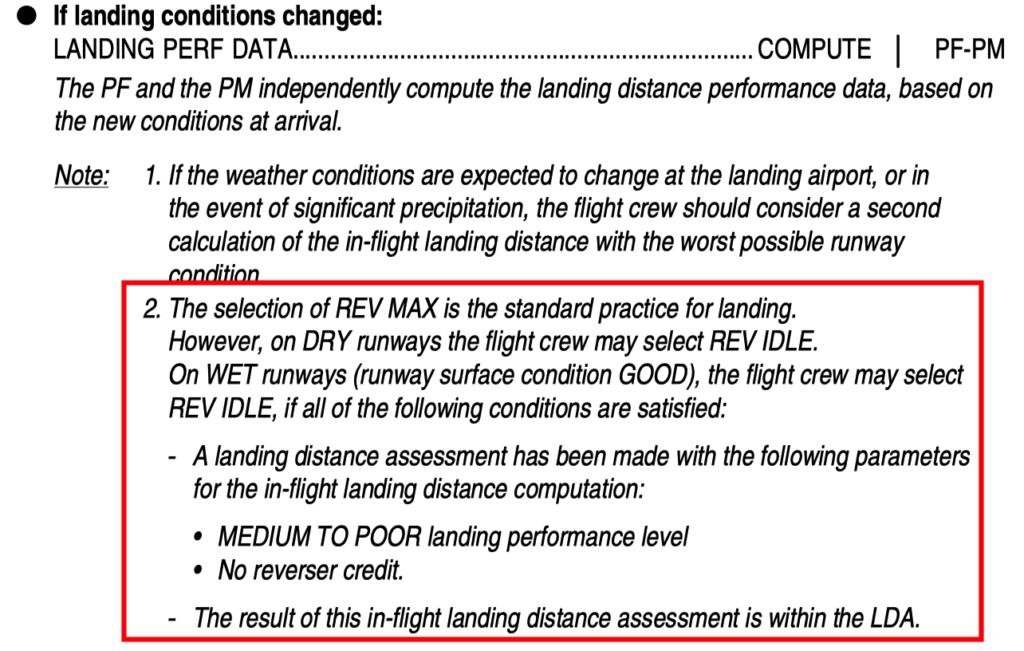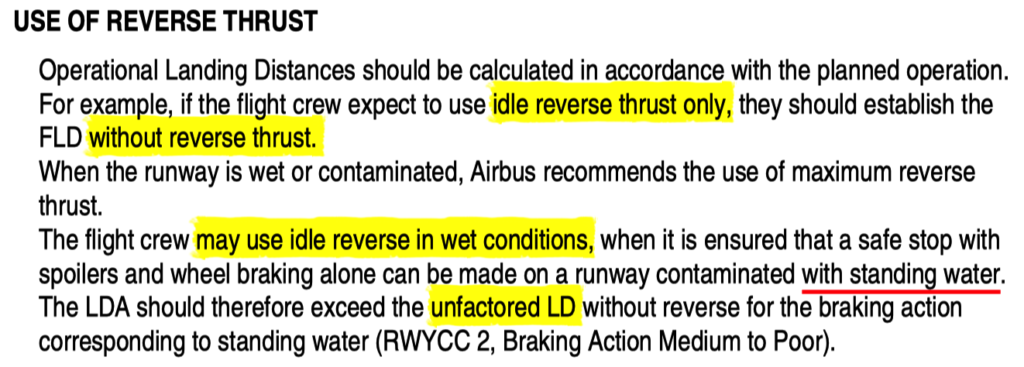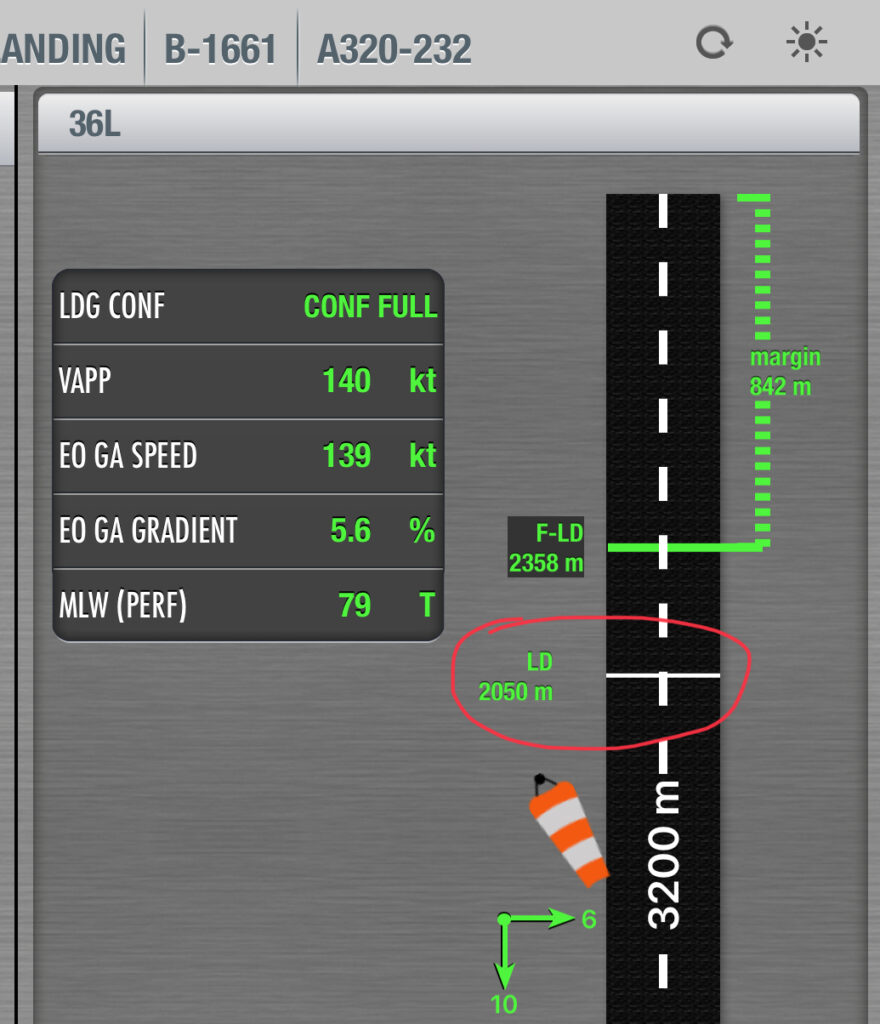еңЁ SOP зҡ„иҝӣиҝ‘еҮҶеӨҮдёӯпјҢе…ідәҺзқҖйҷҶжҖ§иғҪи®Ўз®—жңүдёҖдәӣжіЁйҮҠпјҢе…¶дёӯдёҖжқЎдёҚеҘҪзҗҶи§Јпјҡ
еңЁж№ҝи·‘йҒ“дёҠпјҢеҰӮжһңжңәз»„еҶіе®ҡдҪҝз”Ёе°ҸеҸҚжҺЁпјҢеҲҷйңҖиҰҒдҪҝз”Ёд»ҘдёӢжқЎд»¶жқҘи®Ўз®—пјҡ
- йҒ“йқўжқЎд»¶ MEDIUM TO POOR
- дёҚйҖүжӢ©еҸҚжҺЁ
еҰӮжһңи®Ўз®—еҮәжқҘзҡ„и·қзҰ»е°ҸдәҺ LDAпјҢеҲҷеҸҜд»ҘдҪҝз”Ёе°ҸеҸҚжҺЁгҖӮ
жҢүз…§ FCTM PR-NP-SOP-160 SOP - DESCENT PREPARATION дёӯзҡ„жҸҸиҝ°пјҢеҰӮжһңиҰҒдҪҝз”Ёе°ҸеҸҚжҺЁпјҢеә”иҜҘйҖүжӢ© "NO REV"пјҢиҝҷдёӘжҳҜеҸҜд»ҘзҗҶи§Јзҡ„:
дҪҶй—®йўҳжҳҜпјҡ
жң¬иә«"йҒ“йқўжқЎд»¶ GOOD + NO REV" е°ұе·Із»ҸжҜ”"йҒ“йқўжқЎд»¶ GOOD + REV IDLEвҖқ дёҘж јдәҶпјҢдёәд»Җд№ҲиҝҳиҰҒеҶҚйҖүжӢ©вҖңйҒ“йқўжқЎд»¶ MEDIUM TO POORвҖқе‘ўпјҹ
з©әе®ўеӣһеӨҚдәҶеҫҲеӨҡпјҢж ёеҝғи§ӮзӮ№е°ұжҳҜпјҢжңәеңәйғЁй—ЁжҳҜеҫҲйҡҫе®һж—¶и§ӮеҜҹйҒ“йқўз§Ҝж°ҙжҳҜеҗҰи¶…иҝҮ 3mm зҡ„пјҢд№ҹе°ұжҳҜ"WET"е’Ң"STANDING WATER" зҡ„дёҙз•ҢеҖјпјҢеҗҢж—¶д№ҹжҳҜйҒ“йқўжқЎд»¶"GOOD"е’Ң"MEDIUM TO POOR"зҡ„дёҙз•ҢеҖјгҖӮеҜ№дәҺз§Ҝж°ҙжқҘиҜҙпјҢе°ҸдәҺзӯүдәҺ 3mm RWYCC е°ұжҳҜ 5пјҢеӨ§дәҺ 3mm е°ұжҳҜ 2пјҢдёӯй—ҙзҡ„ 4 е’Ң 3 жҳҜй’ҲеҜ№йӣӘзҡ„пјҢе’Ңз§Ҝж°ҙж— е…ігҖӮеӨҡж¬ЎдәӢ件жҠҘе‘Ҡд№ҹиЎЁжҳҺпјҢеңЁжҠҘе‘Ҡ"WET"зҡ„йҒ“йқўдёҠпјҢжңә组并没жңүж„ҹеҸ—еҲ°жӯЈзЎ®зҡ„еҲ№иҪҰиғҪеҠӣгҖӮ
жүҖд»ҘпјҢдёәдәҶе®үе…Ёиө·и§ҒпјҢеҰӮжһңиҰҒеңЁж№ҝи·‘йҒ“дёҠдҪҝз”Ёе°ҸеҸҚжҺЁпјҢйҷӨдәҶеҜ№вҖңе°ҸеҸҚжҺЁвҖқиҝӣиЎҢдҝқе®Ҳи®Ўз®—дёәвҖңж— еҸҚжҺЁвҖқпјҢиҝҳиҰҒеҜ№вҖңж№ҝи·‘йҒ“вҖқиҝӣиЎҢдҝқе®Ҳи®Ўз®—дёә"STANDING WATER"пјҢжүҖд»ҘеҗҲеңЁдёҖиө·е°ұжҳҜжҢүз…§"йҒ“йқўжқЎд»¶ MEDIUM TO POOR + NO REV"жқҘи®Ўз®—гҖӮ
йңҖиҰҒжіЁж„Ҹзҡ„жҳҜпјҢеңЁдёҠиҝ° FCTM PR-NP-SOP-160 SOP - DESCENT PREPARATION ж–ҮдёӯжүҖиҜҙзҡ„пјҢжҳҜ LDA иҰҒеӨ§дәҺ unfactored LDпјҢд№ҹе°ұжҳҜдёҚеҠ дёҠ 15% зҡ„зқҖйҷҶи·қзҰ»пјҢиҖҢдёҚжҳҜ F-LDгҖӮ
еҸҜиғҪдјҡеҮәзҺ°жҸҗзӨәдҝЎжҒҜпјҡ
TechRequest еҺҹж–Ү
Q:
In PRO-NOR-SOP-160 A LANDING PERF DATA COMPUTE, the description of WET runways computation seems not inaccurate.
For WET runway with REV IDLE, "MEDIUM TO POOR landing performance level" and "No reverser credit" should not be chose at the same time. Because only "GOOD with No reverser" is already more strict than "GOOD with REV IDLE". No need to further downgrade to "MEDIUM TO POOR".
I think it should be "MEDIUM TO POOR with REV MAX" OR "GOOD with NO REVERSER". And verified in FLY SMART, they stop margin of those two are very close.
A:
Please find below the recommendation given in A350 FCOM PRO-NOR-SOP-160 "Descent Preparation":
"Note:
2.The selection of REV MAX is the standard practice for landing.
However, on DRY runways the flight crew may select REV IDLE.
On WET runways (runway surface condition GOOD), the flight crew may select REV IDLE, if all of the following conditions are satisfied:
- A landing distance assessment has been made with the following parameters for the in-flight landing distance computation:
- MEDIUM TO POOR landing performance level
- No reverser credit.
- The result of this in-flight landing distance assessment is within the LDA"
The first point that Airbus would like to highlight is that Airbus recommendation is to use REV MAX for landing.
For In-Flight Landing computation, the performance on WET runway (up to 3 mm of water) should be computed with Runway Condition Code 5 (GOOD) when using REV MAX.
However, following operators' requests, Airbus has performed a study to give the possibility to use REV IDLE instead of REV MAX on WET runway.
In this case, the flight crew must follow the safety precautions as described in the note reminded above: the flight crew must check that the in-flight landing distance computed with Runway Condition Code 2 (MEDIUM TO POOR) and no reverser credit is within the LDA (Landing Distance Available).
Such safety precautions have been defined based on Airbus experience. The aim is to protect against a degraded runway condition, as it is very difficult for airports to observe in real time the potential accumulation of water on the runway aboveВ a depth of 3mm, where the runway condition moves from WET to Standing WaterВ (i.e. from GOOD to MEDIUM TO POOR).
In several in-service events, the flight crew did not have a correct perceptionВ of the braking capability on a runway reported to be WET.
The use of REV MAX is a major mitigation of such unexpected degraded conditions.
When landing with REV IDLE is planned, the exposure to a runway excursion is increased. Thus, Airbus has developed this guidance to ensure a good safe margin for such operations.
Therefore, Airbus would like to confirm that, even if WET runway is Runway Condition Code 5 (GOOD), the in-flight landing performance must be computed without the reverser credit and with MEDIUM TO POOR landing performance level in case of landing with REV IDLE on a WET runway.
If the in-flight landing distance calculated is higher than the LDA, then landing with REV MAX must be performed.
Please note that additional information is given in FCTM PR-NP-SOP-160 "Descent Preparation" / "Landing Performance" / "USE OF REVERSE THRUST" :
"The flight crew may use idle reverse in wet conditions, when it is ensured that a safe stop with spoilers and wheel braking alone can be made on a runway contaminated with standing water. The LDA should therefore exceed the unfactored LD without reverse for the braking action corresponding to standing water (RWYCC 2, Braking Action Medium to Poor)."





